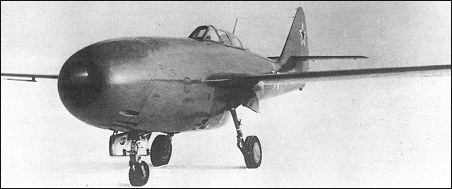|
| Whereas sweptback surfaces had been adopted for
both the La-168 and La-172, the La-174TK, designed to
meet the demands of the same specification as the
latter, featured unswept surfaces. The wing possessed
a thickness ratio of only 6% (the "TK" suffix indicating
Tonkoye Krylo, or Thin Wing) which the
Lavochkin bureau believed might offer most of the
advantages of a thicker sweptback wing while avoiding
some of its disadvantages. The basic configuration
of the La-174TK reverted to that of the earlier La-152
series fighters, although the relationship was confined
to a common design origin, with the single 1590kg NII-1 (RD-500) turbojet exhausting under
the rear fuselage. Armament comprised three 23mm
NS-23 cannon and flight testing commenced early 1948.
Although lighter than the La-172, the La-174TK demonstrated
inferior handling and performance characteristics,
further development being discontinued. The
design bureau designation was reassigned to the replacement
prototype for the La-172 which became the
La-174D.
 | A three-view drawing (1663 x 1183) |
| WEIGHTS |
| Take-off weight | 3315 kg | 7308 lb |
| Empty weight | 2310 kg | 5093 lb |
| DIMENSIONS |
| Wingspan | 8.64 m | 28 ft 4 in |
| Length | 9.41 m | 31 ft 10 in |
| Wing area | 13.52 m2 | 145.53 sq ft |
| PERFORMANCE |
| Max. speed | 970 km/h | 603 mph |
| Range | 960 km | 597 miles |
| Graham Clayton, e-mail, 12.02.2021 07:29 Before the La-174TK even flew, Lavochkin was already studying two infinitely more advanced jet fighter designs, the La-168 and La-174. reply |
|
Do you have any comments?
|
| 
COMPANY
PROFILE
All the World's Rotorcraft
|







